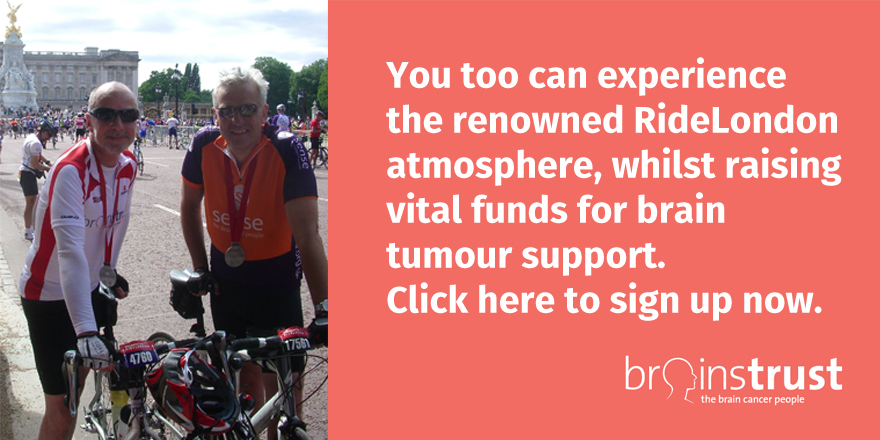
Three years ago my sister Caroline was diagnosed with a brain tumour. It was brainstrust she turned to for advice and guidance during a period where she felt very isolated and uncertain as to what the future held. Via Helen and the team, she was able to meet up with Andrew McEvoy (top neurosurgeon) and receive leading edge treatment – gamma knife radiation. This helped to arrest the growth and start to kill off parts of the tumour.
Caroline and her husband Richard started to attend the brainstrust meet ups and share their experiences with others. I was keen to help in any way possible. Having taken up cycling 5 years ago – and having watched the London Olympics – it seemed logical to try RideLondon.
“Experiencing the Olympic cycle route on closed roads and raising funds for a great cause was very compelling!”
So together with my cycle partner Duncan Aitchison, we trained and raised money via JustGiving. Together we raised close to £5k for brainstrust.
The weather in 2013 was good and the event was an amazing experience – closed safe roads, thousands of fellow cyclists, great crowds lining the route, and the combination of flat London roads and painful Surrey hills – especially Leith Hill!
“Caroline & Richard were there at the finish at The Mall – with Buckingham Palace as a backdrop. It was very emotional- a real feeling of achievement.”
Last year Duncan & I decided to do the London Paris route in 24 hours. So as part of our training regime we picked RideLondon again….
This time the experience was different – pouring rain, hurricane winds, flooded Surrey roads – so bad that 2 Surrey Hills (Leith & Box) were closed off. Duncan suffered 4 punctures and I was lucky to get through unscathed!
“But still the atmosphere was amazing, with everybody helping fellow riders. At the finish (I waited 2 hours for Duncan to arrive!!) I met up with John Tarode from Master Chef! We spent half an hour chatting about middle age bellies and good food”
RideLondon gives cyclists a unique chance to experience the Olympic course (the start point is the Olympic Stadium), to ride on closed safe roads, to conquer Surrey hills and to be supported by thousands of people who line the route.
“This event is the bike equivalent of the London Marathon and I would highly recommend it to anyone – age and ability is irrelevant.”




